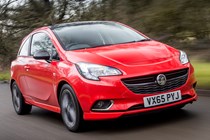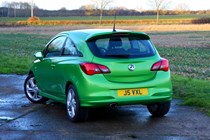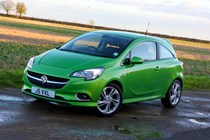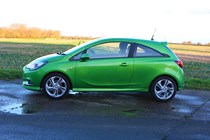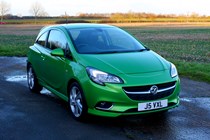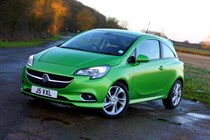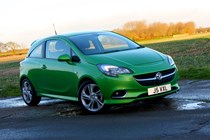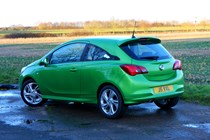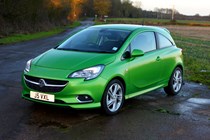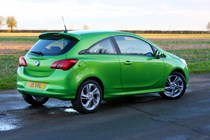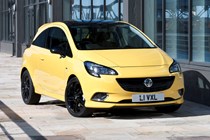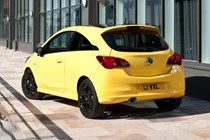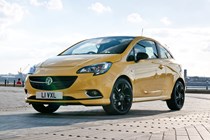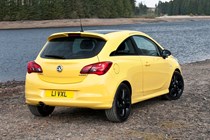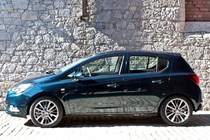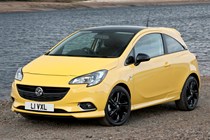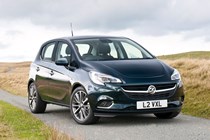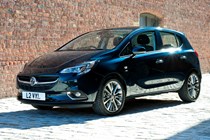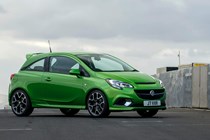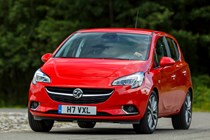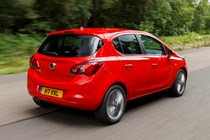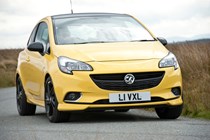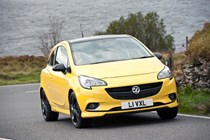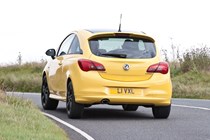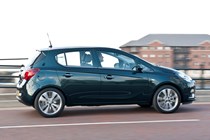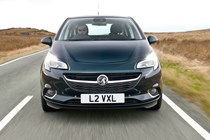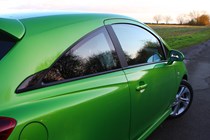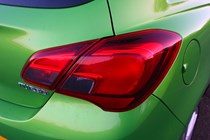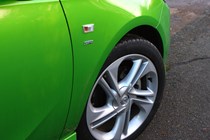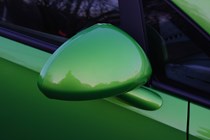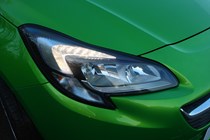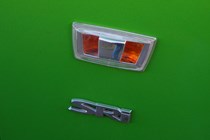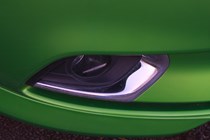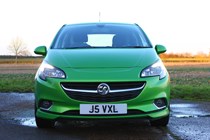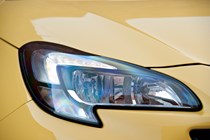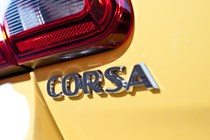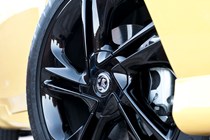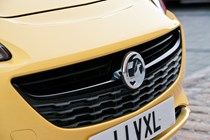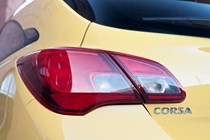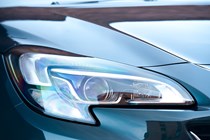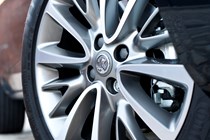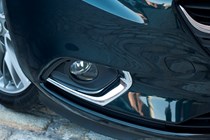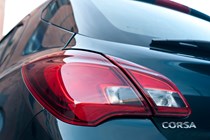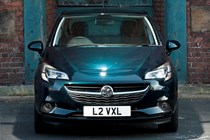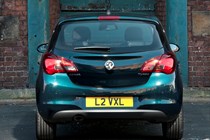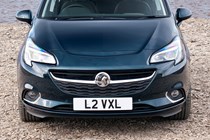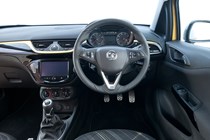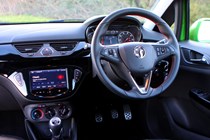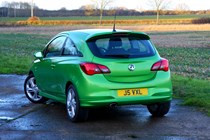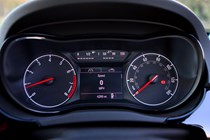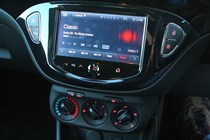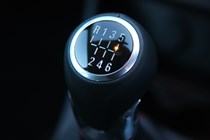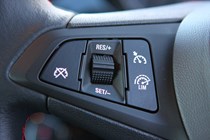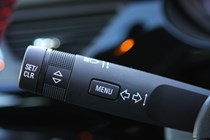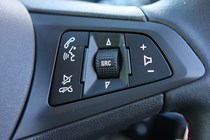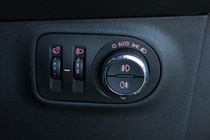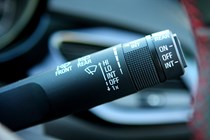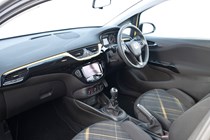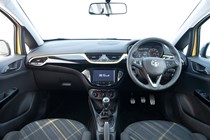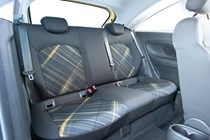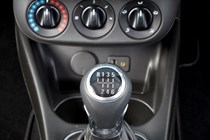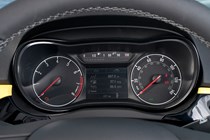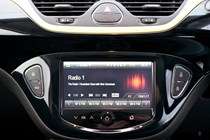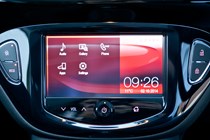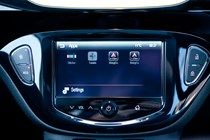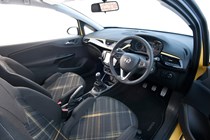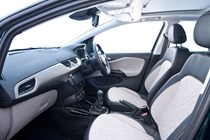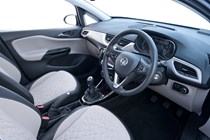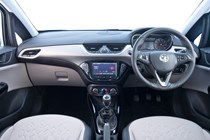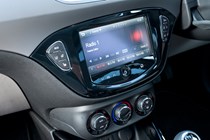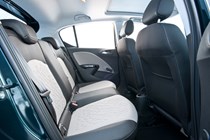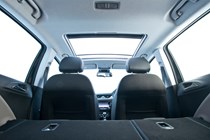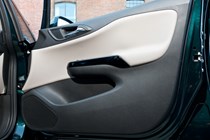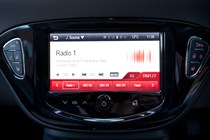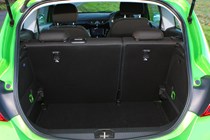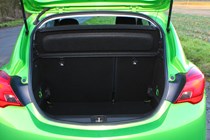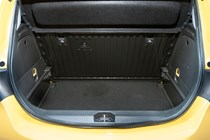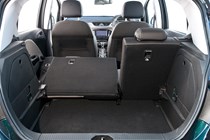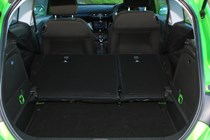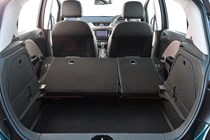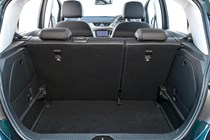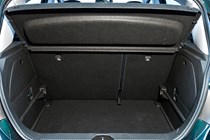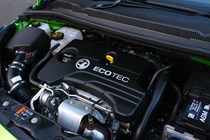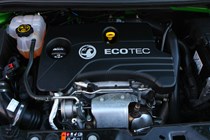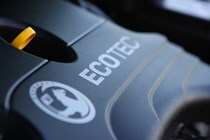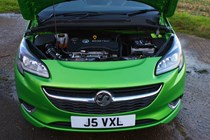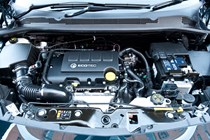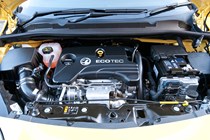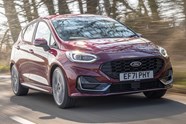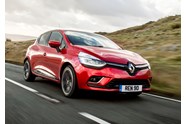
Vauxhall Corsa Hatchback review

At a glance
| Price new | £9,305 - £20,225 |
|---|---|
| Used prices | £2,327 - £9,731 |
| Road tax cost | £0 - £190 |
| Insurance group | 2 - 20 |
Get an insurance quote with

|
|
| Fuel economy | 37.7 - 44.8 mpg |
| Range | 416 - 822 miles |
| Miles per pound | 5.5 - 6.6 |
| View full specs for a specific version | |
Available fuel types
Petrol
Diesel
Pros & cons
- Strong equipment levels for most versions
- Fundamentally reliable and cheap to run
- Sweet 1.0-litre engines from 2014-18
- Based on the old model
- Non-turbo engines give weaker performance
- Not as good to drive as a Fiesta
Vauxhall Corsa Hatchback (14-19) rivals
Overview
The Vauxhall Corsa is a staple of both the new and used car market in the UK. For budget-conscious motorists seeking a cheap-to-run car, its sheer popularity makes it an easy option if you don’t want to overthink things. It may not have the most dynamic reputation, but as a solid and sensible motor that shouldn’t give you any nasty surprises, it’s a safe bet.
Alternatives are many and varied, depending on if your focus is on the size and age of car or the budget you have to spend. If your choice is budget-driven you’ll find newer, lower mileage Corsas for the same cost as rivals such as the Volkswagen Polo or Ford Fiesta Mk7. The Corsa’s platform is shared with the Fiat Punto, the smaller Vauxhall Adam, and the the mini-MPV Vauxhall Meriva.
The 2014-2019 Corsa has a good reputation for reliability – and because so many pass through Vauxhall dealers and independent garages, there’s a huge amount of expertise out there to keep them running on a budget. If you’re thinking of buying a used Vauxhall Corsa, here are 10 things you should know.
Vauxhall Corsa E (2014-19) buying guide
The 2014 Vauxhall Corsa (known in the trade as Corsa E – not to be confused with the latest brand new, pure electric Corsa-e!) was not actually a brand new car at launch. Rather, it was a heavy facelift of the 2006 Corsa D, with a lot of revised bodywork and a fresh, higher-quality interior. This allowed Vauxhall to hone the drive and deliver a smarter cabin with some surprising added tech – many cars, for example, have a comprehensive touchscreen infotainment system.
The 1.4-litre petrol Corsa is the best blend for reliability and easy of maintenance. There is an automatic option which uses a compact, smooth six-speed gearbox – as long as this has been serviced it should be very reliable but watch out for former driving school cars. There is also a five-speed automatic ‘EasyTronic’ which is an automated manual. While generally robust compared with rival systems, it has a conventional clutch to wear out and is difficult to repair.
Hot hatch fans will want the 200hp Corsa VXR. A rival for the Ford Fiesta ST, it’s rare and surprisingly sophisticated, if not quite as user-friendly.
Vauxhall Corsa E known faults and common problems
1. Electrics and gadgets
While fundamentally reliable, the Corsa can be susceptible to some hard to track down electrical gremlins. It’s well worth checking all the equipment works, from electric windows, to the central locking system (do all the doors lock and unlock as they should?), to the electric door mirrors – even the air conditioning. Give the infotainment system a onceover too, making sure the screen is responsive and the system isn’t overly laggy.
On cars with a stop-start system, check that it works once the car is warmed up – then check that it is disabled if you set the heater to demist the windscreen. A failing AGM battery can cause problems and replacement is about 30% more expensive than a standard car battery; most will last seven years before they start to fail.
2. Listen for rattling timing chains
All Corsas have timing chains rather than cambelts. These theoretically are maintenance-free and don’t require changing but in reality, poor servicing and a lack of care can result in the timing chain tensioners wearing – which leads to a rattly timing chain. This isn’t ideal, even though some Corsas carry on motoring with alarmingly noisy timing chains. It’s a simple issue to listen out for when looking at your potential purchase.
High mileage cars can suffer from timing chain stretch even if well maintained. This can lead to misfires and should show in the fault codes when using a diagnostic code reader.
3. Broken USB sockets
Many Corsas of this era come with Apple CarPlay and Android Auto, which is a real boon. Trouble is, the USB sockets can sometimes become glitchy. So take a cable, plug in your phone and make sure it works before you buy. Bluetooth mobile phone connectivity is another option, but you won’t get Apple CarPlay or Android Auto through it.
4. Misfiring and flat spots
Corsa petrol engines should be smooth and surprisingly sweet-running, meaning any engine misfires (and related hesitancy, rough idle and lack of power) will be obvious. They’re usually caused by worn ignition coil packs: some experts advise replacing the spark plugs every 36,000 miles to help prolong the life of the coil packs.
5. Model range, specification and options
Trying to find any pattern in the 2014-2019 Vauxhall Corsa model naming convention is a thankless exercise. There are endless model variants – more than a dozen – which causes lots of confusion. A few rules of thumb: Life and Active are basic, Sting gets alloy wheels, while Excite cars have air-conditioning, a touchscreen infotainment system with DAB radio, heated seats and a heated steering. SRi models get sports seats and SE cars feature parking sensors. At the top of the range is a specialist VXR hot hatch which is best reserved for enthusiasts, as it’s not very cheap to run.
An extensive range of options for trim and equipment means some patient searching should find exactly the Corsa you want. There’s even a FlexFix integrated bike carrier option – which conceals a twin-bike rack behind the number plate. It’s rare, but you can sometimes find the parts to fit it afterwards from car breakers or on eBay.
6. Checking the heated windscreen
A standout feature of all 2014-2019 Vauxhall Corsa E is the standard fitment of a heated windscreen. This is great on wintery mornings, as it can clear ice in just 60 seconds with no scraping required. Just make sure it’s fitted (you’ll be able to see rows of ultra-thin heating elements if you peer up close); if the car’s had a replacement windscreen, a previous owner may have chosen a cheaper screen without the heating function.
If you’re viewing a car on a cold day you may get to see it in action and see how many heating elements have failed. It’s normal for one or two unheated lines to appear with age, but if the screen is mostly unheated it’s a good negotiating point. If half of the screen doesn’t work it may be a broken earth connection, rather than a faulty windscreen.
7. What to look for in the service history
A comprehensive service history is important on a Vauxhall Corsa, not least because of the timing chain wear we mentioned above. Service intervals aren’t onerous: it’s either one year or 20,000 miles. Vauxhall dealers run through a minor-intermediate-major cycle, with a regular service costing around £150.
If you’re considering a diesel Corsa, more frequent oil changes is a very good sign. Most Corsa E diesels are Euro 6 and ULEZ compliant, but some owners may have ‘gutted’ the DPF and used software to bypass the emissions system – we would avoid those, you can tell if it’s been done by an unusually harsh/loud engine when revved.
8. Check the insurance first – not all Corsas are cheap
They may not be fast, but lower-power Vauxhall Corsas have really affordable car insurance. The 1.2-litre engine goes as low as group 2, with the 75hp 1.4-litre starting from group 3. Higher-powered 1.4-litre and the 1.3-litre CDTi diesel come in at group 6, with the 95hp CDTi offsetting its group 8 insurance with free road tax. Just watch the turbo engines: the 1.0T is group 9 and the 1.4T is from group 10 – with the 150hp 1.4-litre GSi commanding an expensive group 20 insurance rating. The 200hp 1.6-litre turbo is even higher.
9. Bodywork damage and cosmetics
As a car driven mainly in the city, it’s always worth checking the condition of the wheels on a potential Vauxhall Corsa purchase. Look at the tyres too, feeling for any bulges in the sidewalls and uneven tread wear. Look along the bodywork for car park dings and dents, and the bumpers themselves for scrapes or cracks – or, indeed, any scrapes or cracks that have been poorly repaired.
Check the headlights carefully, as the LED day running lights, bi-xenon headlight and cornering light setup on higher-specification cars is quite expensive to replace.
10. Clutch wear and gearbox issues – manual transmission
The Corsa is a favourite amongst new drivers, because of how cheap to insure it is. This means it’s worth checking out the condition of the clutch – fresh motorists learning their craft may have slipped it one time too many. Engage a high gear and floor the accelerator to feel for any slip: a high bite point is another giveaway. Remember, a new clutch is upwards of £500. Also, do all the gears engage smoothly, without any crunching? Focus particularly on first and second gear here.
What’s the Corsa E (2014-2019) like to live with?
Over the next few pages, we’ll review each aspect of the 2014-2019 Vauxhall Corsa, taking into account its practicality, comfort, fuel economy and performance. If you’re short on time, you can also skip to our verdict page to see if we recommend the Vauxhall Corsa as a good used car.


